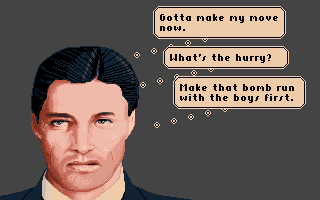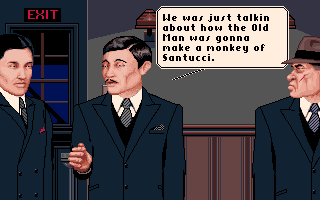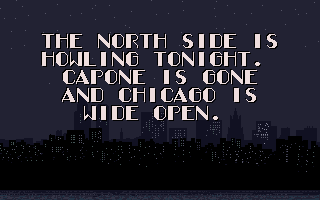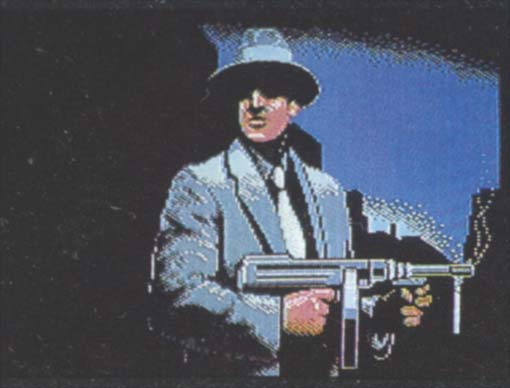
If you have any thoughts of your own on The King of Chicago, or you just want to tell me where I can find an eBook copy of William J. Helmer’s The Gun That Made The Twenties Roar, feel free to hit me up on Twitter or use the Email link at the bottom of the page.
Over the last couple of decades, the Adventure Game hasn’t so much evolved steadily as it has fluctuated in complexity. Starting with typing things like “GET FLASK” and “KILL JESTER” into a primitive terminal, the genre steadily climbed the peaks of graphical prowess and puzzle complexity through the Sierra and LucasArts eras until this old style finally met a commercial demise on account of increasingly ridiculous and esoteric puzzle logic, most famously typified by Gabriel Knight 3’s “cat hair mustache” puzzle solution (and Erik Wolpaw’s furious railing against it).

These “classic style” adventure games would spend a long commercial exile in the frigid wastelands of Germany, being supplanted by a number of substitute genres making their own attempt to fill the void. Two that come to mind are hyper-casual “Hidden Object” games - a sort of digital Where’s Waldo that my mother constantly plays on her iPad and cheerfully describes as “so shit, they’re hilarious” – and Visual Novels, which appear to have originated as (or been shaped by Japan’s niche PC gaming market into) a way for porn illustrators to make a living off their work in the pre-Patreon era, but have since gained an unexpected respect and credibility upon quasi-talented writers descending upon it and at least attempting to write sentences that don’t end with “glopping out onto the sheets”. (Whether those sentences are good is a matter of wide-ranging discussion. One might even say a mass debate continues on the subject. I'm not sorry.)
Of course, history, while not quite repeating, does tend to rhyme, and you can see some echoes of future storytelling-centric gaming (and some ideas that future developers would do well to examine and incorporate) in the ahead-of-its time The King of Chicago, originally put out on the monochrome Macintosh by Doug Sharp through what would become Cinemaware, who would polish up and port it to the 16-bit machines where they would go on to make their name with titles like Defender of the Crown.
The year is 1931, and the Southside mafia boss Al Capone has been sent to Alcatraz, leaving a power vacuum within Chicago’s criminal underworld. Your character, Pinky Callahan, is an ambitious up-and-comer in the rival Northside gang that wants the throne for himself. Your mission is to take over the leadership of the Northsiders, then claim a commanding position over all four corners of the city within three years and wipe the Southsiders out in order to obtain an invitation to join the National Crime Syndicate.

Gameplay primarily consists of making a selection from multiple choices or comments when the time comes, then occasionally engaging in a brief minigame based around reflexes or timing. These minigames typically consist of shooting someone, shooting multiple someones while trying not to hit innocents, hurling bombs through windows, etc. etc. Once you find a way to take over the Northsiders, you also get to balance the books (fun!) to better fund your goals, pick which area of the city to go after next, or talk with your stereotypical gangster-moll girlfriend. Not enormously complex or deep stuff, but it does a good job of furthering the atmosphere.
The thing that makes King memorable to me, and which developers would do a good job to examine, is the way the story uses the advantages of a digital, interactive medium in its telling. Simply put, numerous elements are randomized at the start of the campaign, meaning the story isn’t quite the same twice. This is most apparent in the intro in the Northside HQ – Pinky may start at different times and places within the HQ. The gang may or may not have a bombing planned for later in the evening. The gang’s aging leader may be strong or ineffectual, and the rest of the gang may be for or against the idea of someone else taking his place.
This keeps things far more interesting than the usual static, forked-paths storytelling that most adventure games adhere to, with surprises still able to crop up on a second playthrough, and designer Sharp was rightfully very proud of the “Dramation” system that drives the game and animates the characters. Unfortunately, though, a lot of this is pretty front-loaded – once you take over the gang, the variations tend to thin out a bit, and the game tends to react to the player more than it makes the player react to itself like in the opening.

Sharp and his team push the feel and flavor of an interactive movie as hard as they could in a pre-FMV era, and mobster cinema like The Untouchables and Bonnie and Clyde are the flavor of the day, permeating every piece of the experience. The two disks are labelled as “reels”, the menu is labelled “Projector” instead of “File”, the manual contains essays (including one by author William J. Helmer) on the history and inspirations behind the game, and every between-scene loading screen features silent-movie-style title-cards with commentary like “A LITTLE MAN’S GOTTA DREAM BIG”. The pause screen even resembles an old-time cartoon with dancing lobby refreshments!
Interestingly, the game also lets you continue to play your role as Pinky during certain game over sequences – it doesn’t really matter what your last words are when you’re sitting in the Electric Chair, for example, but you still get the chance to say them... This doesn't really have much of a point from a gameplay perspective, but it really fleshes out the mob-movie vibe, replete with bit-part characters reflecting on your likely-grisly demise. It all adds to the fun, and isn't that what games are for? I mean, at least in theory?

Visually, the game is something of a mixed bag, but how mixed, exactly, depends on the platform. In the original Macintosh release, each character consists of a digitized Claymation head with drawn-on eyes, placed on top of a poorly-drawn body. The monochrome greyscale digitization and the amateurish sculpting gives the game a hilariously and captivatingly grotesque look. (A smarter person than I might say this is to reflect the inner ugliness and brutality of the cast, but honestly, it was probably just a case of low-budget programmer art...) Cinemaware’s re-releases redraw everything, with the heads bearing their trademark captivating pixel-art realism, with the art team (headed by future Trilobyte co-founder Rob Landeros) really pushing everything they and their tools were capable of into each uncanny, cinematic visage. The bodies are still pretty amateurish, though, with very little in the way of detail or shading for the most part, giving the impression that everybody’s a puppet with photographed head glued onto a paper cut-out body.
At its lowest points, King is by and large a choose-your-own-adventure punctuated by simple arcade minigames. At its highest, King is a tantalizing hint of where interactive storytelling could go, and could have gone if it hadn’t made a beeline straight from “KILL JESTER” to “[RENEGADE] PUNCH REPORTER”. Indie developers would do well to play it, take notes, and learn that interactive narrative is just that much more engrossing when the predictability of traditional linear narrative is questioned, and there’s more forks than road.
How To Play It Today

The Macintosh original is interesting for its... unique visual style, but the definitive version for my money is the Amiga version, with its wonderful pixel-art faces and tracker-based music. In comparison, the Atari ST version’s music suffers from some pretty ill-fitting and uninspired chiptunes that maybe kind of resemble the Amiga tracks if you cover your ears, the pixel art is degraded by less colours, and other little stylistic touches (like the big font on the caption scenes) are absent. The less said about the EGA-based MS-DOS port, the better...
Probably the most obscure version to actually reach shelves was for the Sharp X68000 in Japan. It resembles the Amiga version, but with the tracker music replaced by oft-jazzy FM Synth renditions! Also: it's in Japanese. Obviously. A Commodore 64 port was threatened, but never saw the light of day. The only thing pointing to it ever existing was a pixelart graphic in a magazine advertisment. Whether it was a mockup or not remains unknown.
The best way to play the Amiga version is using either WinUAE or my recommendation, FS-UAE. Keep in mind that the floppy disk versions are prone to long (~15-25 seconds or so without using the Warp Mode keybind) loading times, primarily on the title card screens between scenes. The WHDLoad version (basically the floppy release hacked to run off of a hard drive) takes away these load times (to the point that certain title cards literally blink by!) but the music can get knocked slightly off-kilter as a result. Whether that's a deal-killer or not is up to you.
The original Mac version doesn't quite run right under Mini vMac by itself, due to some copy protection trickery messing up the memory stack and crashing the emulated system into a gibberish sea. A hacked version which fixes the issue can typically be found alongside unaltered disk images where such things can be found, and this version runs more or less perfectly. (I say more or less because I had a slightly disconcerting bug later on in my playthrough where a character's face in one scene wasn't drawn, but their eyes and lip-flap sprites were. I'm not sure if that was a bug with the game, emulator or hack...)
What Happened Next

Doug Sharp and his Dramation engine would also put out Free D.C!, a slightly more traditional adventure game. It was the first game by Cinemaware-offshoot Cineplay Interactive (in collaboration with California Raisins commercial animator Will Vinton Studios, of all the people), and it cratered hard enough that it was also their last. I haven’t played it, to be honest. Is it any good?
Sharp went on to be involved for a few years in the Virtual Worlds Group at Microsoft Research in the mid-to-late-90s, working on tools and demos - including one that, according to a description on his Facebook page, may have been Microsoft’s first open-source project. If ever there was a wall that I’d love to have been a fly on...
Sharp later went on to retire from computer stuff as a general concept for a long time due to some very complex health issues. He currently writes sci-fi novels like Channel Zilch, was working to reboot his first game Chipwits and occasionally creates what he affectionately describes as "irritating "music"" from the comfort of a cabin that's might well be in the woods.
Cinemaware continued to put out games from a film-centric angle like It Came From The Desert and Rocket Ranger until the gradual demise of the Amiga dragged them kicking and screaming into the inky, unending night - like so many other developers of their era - around 1992. Amiga lead artist Rob Landeros, as mentioned, went onto some stuff that changed the medium forever and some stuff that, uh, maybe missed the mark a little. Audio guy Bill Williams lived a short but eventful life that could be several articles in itself. His Amiga work climaxed with the incredible and inexplicable Knights of the Crystallion, which only Shadsy can educate you on...
Sometime circa 2013-2014, some creature wearing Cinemaware's skin put out mobile ports for iOS and Android. These were simply the Amiga version thrown into a low-quality emulator. They are no longer available, for better or for worse, and you'll need to use other options like UAE4ARM if you want to claim the crown while on the throne.
| Go Back, Foul Demon! | To the Top | Get in Touch |